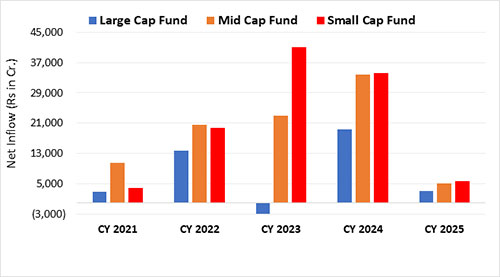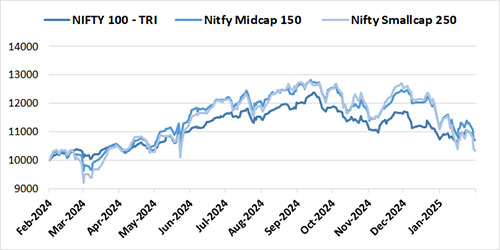Decoding the Recent Market Correction: What’s Behind the Fall in Mid and Small Caps
Rounaq Neroy
Feb 14, 2025 / Reading Time: Approx. 8 mins
Listen to Decoding the Recent Market Correction: What’s Behind the Fall in Mid and Small Caps
00:00
00:00
The Indian stock market recently witnessed a sharp correction, particularly in the Small and Mid-cap segment or SMIDs as they are popularly called.
Investors who have been riding high on the robust gains in these segments are caught off guard as prices plummeted.
This market crash is due to a mix of domestic and global factors at play and against the backdrop of foreign investors dumping Indian equities, particularly SMIDs.
Historically known for their high growth potential but equally high volatility, the mid and small-cap segments have borne the brunt of the sell-off the most, prompting fears of a prolonged downturn. The BSE Small Cap Index and the BSE Mid Cap Index have corrected 18.3% and 17.9%, respectively (as of February 12, 2025).
Table: Notable Decline in Mid and Small-Cap Stocks from their All-Time Highs
| Particulars |
BSE SENSEX |
BSE Mid-Cap |
BSE Small-Cap |
| All-time high (Dates) |
26-Sep-2024 |
24-Sep-2024 |
11-Dec-2024 |
| All-time high level (in points) |
85,836.12 |
49,621.69 |
57,703.48 |
|
|
|
|
| Level as of Jan 1, 2024 (in points) |
72,271.94 |
37,036.77 |
42,986.53 |
| Level as of Feb 12, 2025 (in points) |
76,171.08 |
40,760.39 |
47,136.37 |
|
|
|
|
| Correction since the all-time high (%) |
-11.3% |
-17.9% |
-18.3% |
Data as of February 12, 2025
Past performance is not an indicator of future returns.
(Source: ACE MF, data collated by PersonalFN Research)
At the recently held 15th IFA Galaxy event, the CIO of ICICI Prudential Mutual Fund, S. Naren, highlighted investors need to be cautious about investing in SMIDs now, citing valuation concerns.
Graph 1: Cumulative Net Inflows Across Large, Mid, and Small Cap Funds
 Data as of February 12, 2025
Data as of February 12, 2025
(Source: AMFI, data collated by PersonalFN Research)
S. Naren cited this considering that Small Cap and Mid Cap Funds have witnessed sustained inflows in the past couple of years, particularly after the COVID-19 pandemic. Investors, retail and HNIs in particular, based on their past experience are showing their love for SMIDS but are perhaps oblivious to the fact that past performance may not necessarily be sustained in the future.
The rapid reversal in market dynamics has raised questions about the sustainability of past performance of SMIDs. There is a growing preference for stability with uncertainty looming and foreign investors are supposedly reallocating to large caps and mega caps.
Graph 2: SMIDS Cracking Under Pressure
 Data as of February 12, 2025
Data as of February 12, 2025
Past performance is not an indicator of future returns.
(Source: ACE MF, data collated by PersonalFN Research)
From the graph, it's clear, the Nifty Midcap 150 and Nifty Smallcap 250 indices have plummeted from their peak levels. Meanwhile, the Nifty Large Cap index is also feeling the heat but the relative decline is much less over the same period.
Investors are grappling with heightened volatility, leading to a wave of panic selling and a sudden erosion of portfolio values. Some of the key reasons behind the selling are:
-
Amid global uncertainties, bond yields in developed economies, particularly in the U.S., are rising. As a result, foreign investors have shifted their focus towards fixed-income investments. A fact is that the U.S. Dollar is also much stronger with the U.S. economy doing well on many macroeconomic indicators.
-
Another critical factor behind the market meltdown is the weaker-than-expected Q3FY25 earnings. Many mid and small-cap companies have missed market expectations. Moreover, in certain cases, margins seem to have compressed. On the other hand, large-cap stocks, particularly in banking and FMCG, have shown resilience.
-
The higher financing costs are further weighing down on the growth prospects and debt servicing ability of SMIDS.
-
The RBI's latest consumer confidence survey too is not very optimistic about the economic situation, employment, and income, consumers are witnessing higher costs of living, and thus holding back on non-discretionary spending.
-
The fact also is, as S Naren has rightly pointed out, that despite the correction in SMIDS valuations are expensive. The Price-to-Earnings multiple of SMIDS is way more than large caps. Although there is a decrease in the BSE Small Cap Index Price-to-Earnings (P/E) ratio to 29x (as of February 2025) from 34x seen in December 2024 and the BSE Mid Cap Index Price-to-Earnings (P/E) ratio currently at 34x from 40x during the same period, valuations remain elevated. As the market recalibrates valuations, investors are becoming more cautious, leading to a rebalancing of portfolios.
While the short-term volatility may persist, long-term investors could find opportunities to invest in quality stocks at more attractive valuations.
Graph 3A & 3B: Valuation Trends - Midcap & Small cap to Sensex Ratio
 Data as of February 12, 2025
Data as of February 12, 2025
Past performance is not an indicator of future returns.
(Source: ACE MF, data collated by PersonalFN Research)
The Small Cap Index-to-Sensex ratio stands at approximately 0.6, significantly above its long-term median of 0.5.
The midcap-to-Sensex ratio mirrors the small-cap trend, with the ratio at approximately 0.5 hovering above its long-term median of 0.4.
Despite recent corrections in the broader market, mid and small-cap indices continue to show elevated valuations compared to their long-term averages.
This indicates that these segments have not fully corrected and are still expensive. Unless this ratio drops below the long-term median, it cannot be considered reasonable.
This raises concerns, that while SMIDS offer high growth potential, current valuations pose a significant risk. The froth in the mid and small segments of the market has still not settled much.
Investors, therefore, should exercise caution and avoid chasing potential returns at unjustifiably high prices.
While the optimism surrounding India's economic growth trajectory may seem to support the narrative that SMIDs are well-positioned to benefit in the long run, the margin of safety does not seem to be very comforting at present.
Should Investors Stop SIPs in Small Cap Funds and Mid Cap Funds?
SIPs are often promoted as a prudent way to invest in equities by averaging costs during market volatility. However, it is not true that the investors' experience in SIPs will be pleasant and rewarding always.
SIPs work best in a volatile market, of course, but they work to the investors' advantage in Small Cap Funds and Mid Cap Funds when valuations have almost bottomed out.
Currently, valuations in SMIDs are nowhere near the bottom when we see the PE ratios or the smallcap-to-sensex ratio and the midcap-to-sensex ratio.
If one is investing in Small Cap Funds and Mid Cap Funds through SIPs for an investment horizon of 3-5 years, it may not turn out to be a very pleasant and rewarding experience.
To invest in Small Cap Funds and Mid Cap Funds investors need to have a longer horizon -- 8-10 years or more -- to reap meaningful SIP returns. This shall harness the power of compounding and help mitigate the risk (with the inherent rupee-cost-averaging feature of SIPs)
The key to maximizing the benefits of SIPs lies in maintaining a long-term investment horizon, aligning the fund choices with suitability to your risk tolerance and financial goals, and being disciplined. Unfortunately, not many investors do this; they indulge in panic selling.
For long-term investors, staying invested and avoiding panic selling during such volatility has historically proven to be more beneficial.
Follow a Core & Satellite Approach to Invest in Mutual Funds Now
The core & satellite investment strategy is followed by some of the most successful equity investors around the world. It has proven to be a sensible way to deploy money into equity funds to address long-term financial goals.
Typically allocate 65%-70% of the equity mutual fund portfolio to some of the best Large Cap Funds, Flexi Cap Funds/Multi-Cap Funds, and Value/Contra funds for stability and long-term growth.
The satellite portion, comprising up to 30%-35% of the equity portion, includes a couple of best Mid Cap Funds (max 2) and an Aggressive Hybrid Fund.
If you, the investor, are already holding some of the best Mid Cap Funds in your satellite portfolio, avoid making fresh investments. Likewise, steer clear from fresh investment into Small Cap Funds. If you are already holding a worthy Small Cap Fund in the portfolio, limit exposure to 10%-15%.
Make sure the satellite holdings of the equity mutual fund portfolio are held with at least an 8-year horizon or more to ride out short-term volatility.
While market corrections are part of the investment cycle, adopting a well-thought-out strategy like the Core & Satellite approach shall help mitigate risks. The core portion shall add stability, while the satellite portion push up the overall returns of the portfolio.
For tactical asset allocation to equity, debt, and gold, a Multi Asset Allocation Fund would also be a meaningful choice now.
Keep investments aligned with your financial objectives and take advantage of opportunities when market conditions improve.
Rather than reacting impulsively to short-term market fluctuations, staying the course with a well-thought-out strategy can help weather the storm and capitalize on future growth opportunities.
Remember to make informed decisions and invest wisely.
Be a thoughtful investor.
Happy Investing!
We are on Telegram! Join thousands of like-minded investors and our editors right now.
-New.png)
ROUNAQ NEROY heads the content activity at PersonalFN and is the Chief Editor of PersonalFN’s newsletter, The Daily Wealth Letter.
As the co-editor of premium services, viz. Investment Ideas Note, the Multi-Asset Corner Report, and the Retire Rich Report; Rounaq brings forth potentially the best investment ideas and opportunities to help investors plan for a happy and blissful financial future.
He has also authored and been the voice of PersonalFN’s e-learning course -- which aims at helping investors become their own financial planners. Besides, he actively contributes to a variety of issues of Money Simplified, PersonalFN’s e-guides in the endeavour and passion to educate investors.
He is a post-graduate in commerce (M. Com), with an MBA in Finance, and a gold medallist in Certificate Programme in Capital Market (from BSE Training Institute in association with JBIMS). Rounaq holds over 18+ years of experience in the financial services industry.
Disclaimer: Investment in securities market are subject to market risks, read all the related documents carefully before investing.
This article is for information purposes only and is not meant to influence your investment decisions. It should not be treated as a mutual fund recommendation or advice to make an investment decision in the above-mentioned schemes.